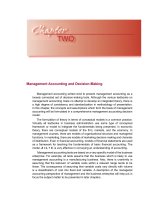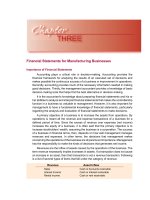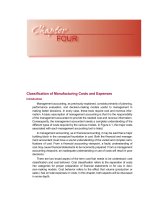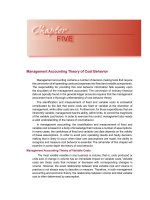Nen Tang Cua Ke Toan Quan Tri Chaper 4
Bạn đang xem bản rút gọn của tài liệu. Xem và tải ngay bản đầy đủ của tài liệu tại đây (506.91 KB, 12 trang )
Management Accounting
| 51
Classication of Manufacturing Costs and Expenses
Introduction
Management accounting, as previously explained, consists primarily of planning,
performance evaluation, and decision‑making models useful to management in
making better decisions. In every case, these tools require cost and revenue infor‑
mation. A basic assumption of management accounting is that it is the responsibility
of the management accountant to provide the needed cost and revenue information.
Consequently, the management accountant needs a complete understanding of the
different types of costs required by the various models. In Figure 4.1, the major costs
associated with each management accounting tool is listed.
In management accounting, as in nancial accounting, it may be said that a major
building block in the conceptual foundation is cost. Both the nancial and manage‑
ment accountant must have a sound understanding of the varied and complex rami‑
cations of cost. From a nancial accounting viewpoint, a faulty understanding of
cost may cause nancial statements to be incorrectly prepared. From a management
accounting viewpoint, an inadequate understanding or use of costs will result in poor
decisions.
There are two broad aspect of the term cost that needs to be understood: cost
classication and cost behavior. Cost classication refers to the separation of costs
into categories for proper preparation of nancial statements or for use in deci‑
sion‑making models. Cost behavior refers to the effect that volume (production or
sales ) has on total expenses or costs. In this chapter, both aspects will be discussed
in some depth.
52 |
CHAPTER FOUR
•
Classication of Manufacturing Costs and Expenses
Cost Classication
In accounting, the term cost refers to the expenditure or sacrice made to acquire
something of value. In nancial accounting, all transactions are recorded in terms
of historical cost; that is, the money expended or to be expended at the date of the
transaction. The monetary value associated with an asset acquired is said to be its
cost. Cost is the sacrice made in resources to acquire another resource. Cost is
measured in monetary units which in the United States is the dollar. For example, a
machine is purchased by paying $4,000 in cash and trading in an old machine having
a sales value of $1,000. The cost of the new machine is $5,000 because resources
worth a total of $5,000 were given in the exchange. Stated differently, resources
worth $5,000 were sacriced.
Figure 4.1
Tools Cost Information Required
Flexible Budget Fixed and variable costs
Cost‑volume‑prot analysis Fixed and variable costs
Direct costing Fixed and variable costs
Budgeting Planned data, xed and variable costs
Variance analysis Fixed and variable costs
Incremental analysis Escapable , opportunity, relevant
Segmental reporting Indirect costs, direct costs
Inventory models Purchasing cost, carrying cost
Present value models Cash inows, cash outows
Depending on the type of activity and the passage of time, the cost of an asset in
accounting can be classied in several ways. Proper nancial reporting and correct
decision‑making require an understanding of the different ways in which costs can
be classied. In Figure 4.2 is a list of costs that pertain to both nancial statement
preparation and decision‑making analysis.
For purposes of management accounting, there are three important dual classica‑
tions of cost that require some understanding: Expired and unexpired, manufacturing
and non manufacturing, and xed and variable. These three classications are
somewhat interrelated, particularly concerning nancial statements.
Expired and Unexpired Costs
Expired costs or expenses are the used up value of assets. Expired costs are
always shown on the income statement as deductions from revenue. Expired costs
may be thought of as that portion of the asset value benetting current operations.
It is helpful to think of expired costs as former assets values. To illustrate, supplies
expense is an expired cost. The cost allocated to supplies expense, of course, is
the used portion of supplies, an asset. The relationship between asset values and
expired costs is further illustrated in Figure 4.3.
Management Accounting
| 53
Figure 4.2
Financial Statements Cost Concepts Management Accounting Cost Concepts
(Decision‑making Cost Concepts)
Direct and indirect
Prime
Joint
Fixed and variable
Manufacturing and non manufacturing
Expired and unexpired
Expenses
Fixed and variable expenses
Relevant and irrelevant
Escapable and inescapable
Sunk
Fixed and variable
Opportunity and sunk
Incremental
Direct and indirect
Mixed, semi‑variable
Carrying cost, purchasing cost
Manufacturing Costs/Expenses
The difference between a cost and an expense is frequently misunderstood.
Because the terms variable costs and variable expenses will be used later in this
chapter, and also throughout this book, the difference in meaning between a cost and
a expense will now be claried.
Technically, there is a difference between a manufacturing cost and a manufac‑
turing expense. The term manufacturing costs usually refers to material used, direct
labor incurred, and overhead incurred in a manufacturing business. Material used,
direct labor, and manufacturing overhead at the time incurred are not expenses; rather
they incurred costs. In the manufacturing process, material, labor, and overhead do
not expire; rather through manufacturing activity they become transformed from one
type of utility to another.
In a manufacturing business, the accountant will debit work in process for mate‑
rials used, direct labor incurred, and manufacturing overhead. Since work in process
is an asset account, it would not be logical to regard material used, direct labor, and
manufacturing overhead as expenses. Expenses cannot be transformed back into
asset values.
Figure 4.3
Asset Values and Related Expenses
Asset Expired
Accounts receivable
Finished goods
Prepaid insurance
Supplies
Building
Bad debts expense
Cost of goods sold
Insurance expense
Supplies expense
Depreciation
Manufacturing costs, however, do eventually become manufacturing expenses
Material used, direct labor incurred, and manufacturing overhead are rst recorded
54 |
CHAPTER FOUR
•
Classication of Manufacturing Costs and Expenses
in inventory accounts (work in process and nished goods) and then become an
expense when nished goods are sold. In a manufacturing business, only the cost
of goods sold account can properly be called a manufacturing expense. Prior to the
sale of nished goods, all manufacturing expenditures remain as unexpired costs.
In order to understand the transformation of manufacturing costs into manufacturing
expenses, you should fully understand the ow of cost as taught in cost accounting.
The ow of cost diagram is shown in Figure 4.4.
The term, variable cost, then primarily refers to the manufacturing costs that are
reected in the inventory accounts: materials, work in process, and nished goods.
The term, variable expenses, refers to cost of goods sold and to other variable
non manufacturing expenses such as sales people’s commissions. As a student
of management accounting, you should understand, however, that the two terms,
variable expenses and variable costs, are sometimes used interchangeably. Some
writers use the term variable costs to include variable expenses. The technical differ‑
ence is ignored because the theory underlying the use of variable expenses is the
same as for variable costs.
There is one instance in which manufacturing costs and manufacturing expenses
(cost of goods sold) are the same in amount. When sales equal production, that is, all
units manufactured are sold, then manufacturing costs (materials used, direct labor
incurred, and manufacturing overhead incurred) and the manufacturing expense (cost
of goods sold) are equal. Under these conditions, all manufacturing costs including
xed manufacturing overhead incurred will be included in cost of goods sold.
In terms of nancial statements, manufacturing costs appear on the cost of goods
manufactured statement while manufacturing expenses are shown on the income
statement. However, the amount of manufacturing costs are not necessarily reported
on the income statement in the period incurred. Some of the current period manufac‑
turing cost may still reside in nished goods inventory until the inventory is sold.
Materials
Direct Labor
Manufacturing Overhead
Work in Process
Finished Goods
Cost of Goods Sold
Note: The flow lines denote journal entries at the end of the
accounting period to transfer cost.
Figure 4.4 • Flow of Manufacturing Cost
Management Accounting
| 55
Manufacturing and Non Manufacturing Costs
The distinction between manufacturing and non manufacturing costs is important
because this dual classication is reected in different types of nancial statements
for the manufacturing business: the income statement and the cost of goods manu‑
factured statement. The cost of goods manufactured statement shows all the current
period manufacturing costs while the income statement shows all the current non
manufacturing expenses. In order to understand the direct relationship of the income
statement and the cost of goods manufactured statement, it is necessary to under‑
stand the distinction between manufacturing and non manufacturing costs.
Manufacturing costs may be simply dened as materials used, direct labor
incurred, and manufacturing overhead incurred. These are the costs that are found
on the cost of goods manufactured statement. Non manufacturing costs (techni‑
cally, expenses) are those expenses commonly called selling and administrative.
These are the expenditures incurred in the current period directly for the benet of
generating revenue. Non manufacturing expenses should not be included in the cost
of inventory. The term is somewhat misleading because the “cost” part of the term
implies unexpired costs when it fact it has reference to expenses. Since “non manu‑
facturing costs” are, in fact, expired costs (expenses), then technically a better term
would be “non manufacturing expenses.”
After some costs have been classied as manufacturing, they are normally further
classied as direct and indirect. Materials used in the manufacturing process are
either used directly or indirectly. Direct material is material that becomes part of the
nished product and, therefore, signicantly adds to the weight or size of the product.
If the nal product, for example, is a wooden chair, then the wood used to make the
legs, seat, and back is a direct use of material. Materials such as glue and screws,
usually not signicant in amount, are often regarded as an indirect use. Also material
issued but not becoming a part of the nal product and used for manufacturing objects
such as saw horses or shelves to store paint or other incidental materials would be
regarded as an indirect use of material.
In a similar manner, factory labor is normally classied as either direct or indirect.
Consequently, two types of labor are recognized: direct factory labor and indirect
factory labor. Direct factory labor is the cost of labor incurred while work is done on
the product itself. Normally, in one way or another, direct labor affects the physical
appearance of the product. Some factory workers do not actually work on the product
itself but provide services necessary to the over‑all manufacturing process. Janitorial
services, repair and maintenance service, supervision of direct workers, and computer
support are examples of labor incurred that would be regarded as indirect.
The signicance of classifying material and labor as an indirect cost is this: indirect
material and indirect factory labor are recorded as manufacturing overhead and,
therefore, becomes a part of the cost of the nal product through the use of overhead
rates. The recording of direct and indirect manufacturing cost may be illustrated as
the following journal entry:









